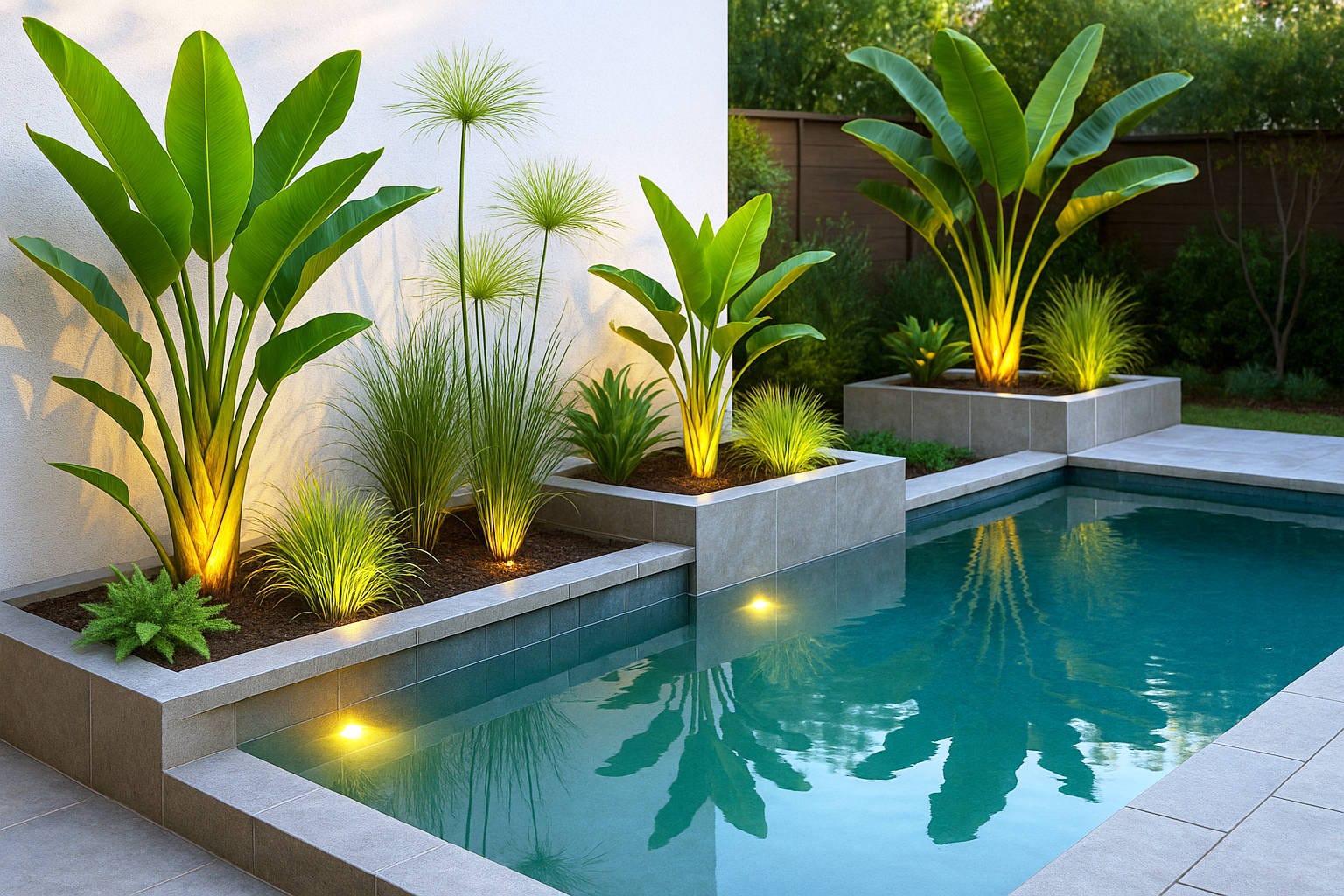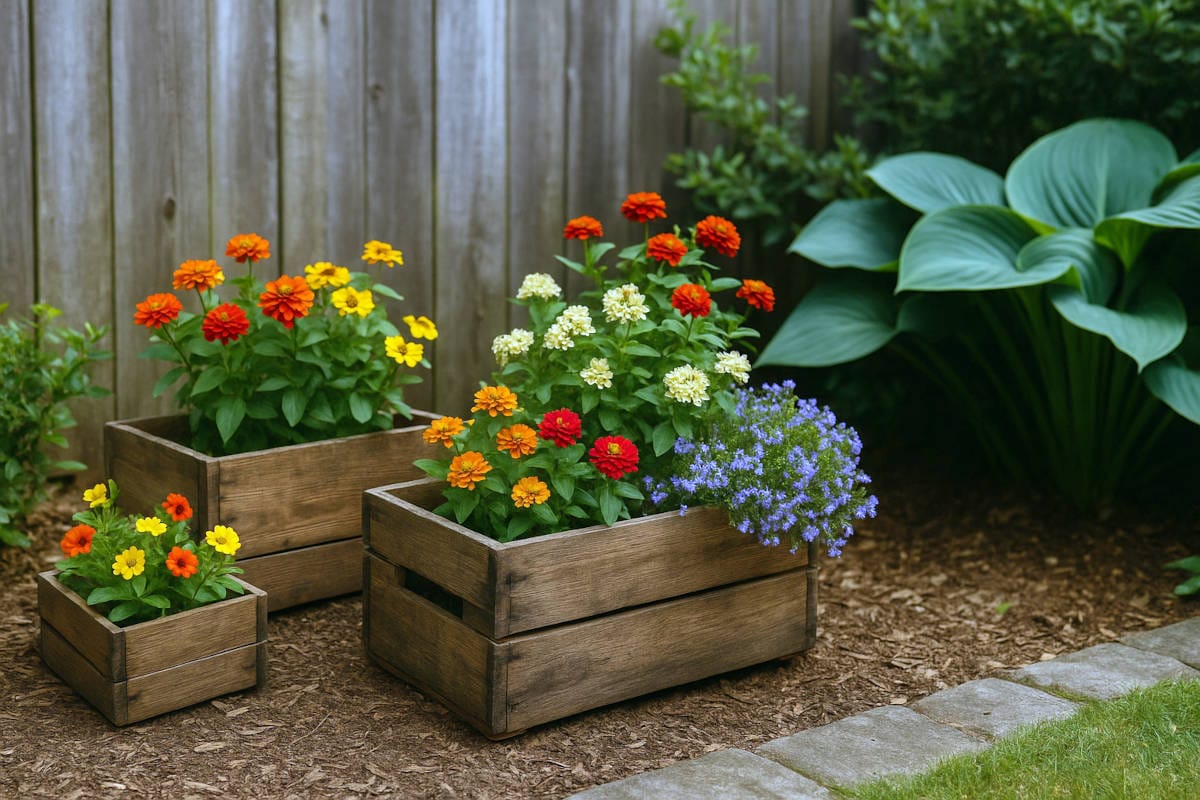Ever heard of a planter pool? If not, you’re about to get obsessed. This clever outdoor design idea blends water features with plants — and no, it’s not just for high-end resorts or fancy Pinterest boards. Anyone with a bit of space and creativity can build one, and the results are seriously worth it.
In this post, we’re diving into everything you need to know: what a planter pool really is, how to build one, 5 inspiring design ideas, plant suggestions, maintenance tips, and a few smart tricks to keep it all looking amazing year-round.
By the end, you might be dreaming up your own little jungle oasis (or desert paradise, or Mediterranean courtyard… yep, we’ve got those too).
Stick around. You’re going to get ideas that grow on you — literally.
What Is a Planter Pool?
Let’s clear something up right away: a planter pool isn’t some fancy new name for a swimming pool. It’s more like a smart design move that brings greenery and water together in the same space.
Think of it like this: you’ve got a pool or water feature, and instead of just surrounding it with pavement or grass, you integrate planters right into the layout. These can be built-in beds along the edges, freestanding containers, or even floating planters that sit on the water’s surface.
The result? A seamless, natural look where plants and water feel like they were made for each other.
This idea works with all kinds of pools: large, small, shallow, deep, even decorative water basins that aren’t meant for swimming. It’s all about how you combine the elements: water + plants + design = that wow factor your backyard’s been missing.
Some folks go tropical, with big leafy plants hanging over the pool’s edge. Others keep it minimal, like a Zen garden with bamboo and still water. There are even desert-inspired planter pools with succulents and sand-colored stone. The design options are endless.
And yeah, it’s not just about looking good. A well-designed planter pool can help cool down the area, attract pollinators, improve air quality, and give your space that relaxing “I never want to leave here” vibe.
Now that you know what it is, let’s talk about why it’s actually a great idea.
You may also like:
- Dragon Tail Plant Guide: How to Grow Epipremnum Pinnatum
- Brazilian Wood Plant Care: How to Grow It in Soil or Water Indoors
Benefits of Adding a Planter Pool to Your Garden
So, why go through the trouble of mixing plants with water features? Because it seriously pays off — visually, emotionally, and even environmentally.
A planter pool doesn’t just sit there looking pretty (though it definitely does that). It actually improves your garden space in a bunch of smart ways.
1. Next-Level Aesthetics
Let’s be real, planter pools look amazing. They add depth, movement, and texture that you just don’t get with plain grass or tiles. Plants soften the hard edges of a pool and make the whole area feel more alive.
2. Better Microclimate
Plants around water help regulate the temperature of the space. They can offer shade, reduce heat buildup around stone or concrete, and cool the air naturally. It’s like your garden’s own built-in climate control.
3. Wildlife-Friendly
Want butterflies, bees, and birds to hang out more often? A planter pool gives them a reason to stop by. Flowering plants and water attract pollinators, while shaded spots offer shelter for small creatures.
4. Low-Maintenance Landscaping (If You Do It Right)
Believe it or not, the right combination of plants and layout can cut down on yard work. Choose native or drought-tolerant species, add drip irrigation, and boom — less weeding, watering, and worrying.
5. It Feels Amazing
There’s something about sitting near water, surrounded by greenery, that just resets your mood. Whether it’s for morning coffee, evening wine, or just a breath of calm in your day, a planter pool becomes your go-to escape.
You may also like:
- The Spider Plants Guide: Benefits, Planting, and Maintenance
- 11 Container Gardening Ideas for Small Spaces and Patios
How to Build a Planter Pool: Step-by-Step
Thinking about building your own planter pool? Don’t worry, it’s not as complicated as it sounds. You don’t need a full renovation team or a massive yard. You just need a plan, the right materials, and a little patience. Here’s how to get started:
1. Choose the Right Spot
Look for a space that gets decent sunlight (unless you’re planning a shaded jungle vibe). Bonus points if it’s near a seating area or visible from inside your home. The planter pool should feel like part of your everyday environment, not just some corner you forget about.
2. Decide on the Layout
Do you want a shallow basin with floating planters? A raised bed wrapping around a plunge pool? Maybe a sleek strip of planters built into a deck? Sketch it out or use a garden design app. Keep in mind water flow, plant access, and safety.
3. Prep the Structure
For built-in styles, you’ll need to dig and frame the pool or basin area, then waterproof it (don’t skip this part). Use concrete, stone, or prefab fiberglass shells. Add planter zones with proper drainage layers — think gravel at the bottom, then soil or potting mix on top.
4. Add Your Plants
Now the fun part. Choose plants based on your climate and style (more on this in the design ideas section). Make sure the roots won’t invade the water structure, and don’t overcrowd — give everything room to grow.
5. Finish with Details
Install a basic drip system, set up ambient lighting, and maybe even toss in a bench, lantern, or outdoor rug nearby. A few thoughtful extras can turn this from “nice” to “unreal.”
Planning something small? You can even create a mini planter pool using a large ceramic pot, water, and a mix of aquatic and container plants. Seriously, it works on a balcony, too.
You may also like:
- Tomato Plant Leaves Turning Yellow? 7 Causes and Easy Fixes
- Compost Bin: The Complete Beginner’s Guide to Easy Home Composting
5 Beautiful Planter Pool Ideas to Inspire You
You’ve got the basics down, now let’s bring it to life. Here are 5 stunning planter pool ideas you can totally steal (or tweak). Each one has a different vibe, and they all work in home gardens, big or small.
1. Tropical Serenity
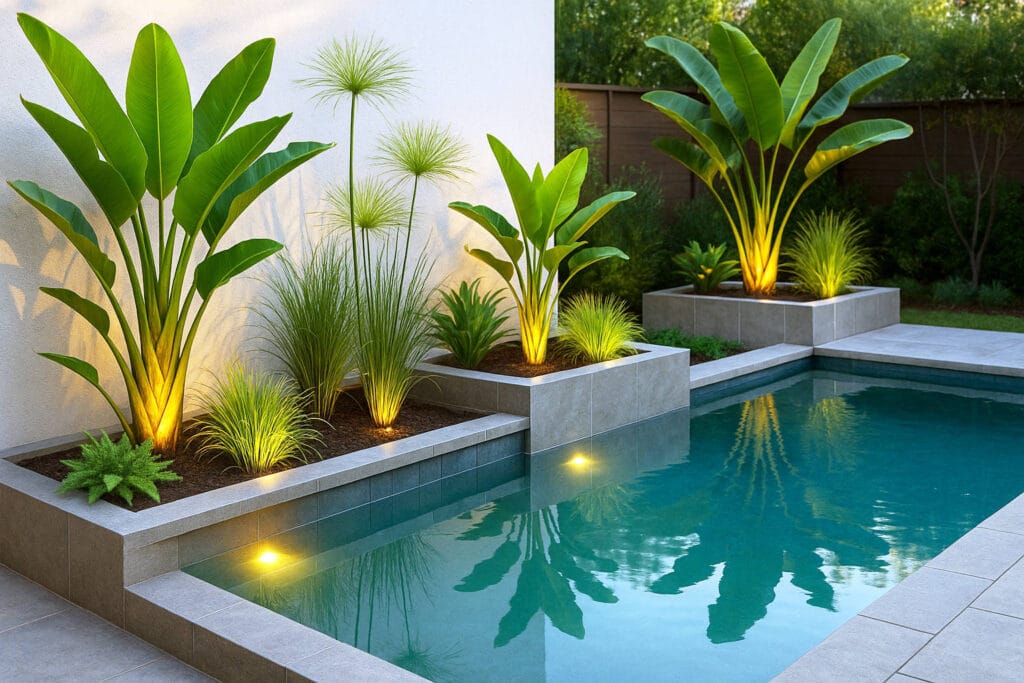

Imagine sipping something cold while surrounded by banana leaves, papyrus, and strelitzias. This design uses raised planter beds inside or around a pool, filled with lush tropical plants. Think spa energy, minus the expensive resort.
- Best plants: Bird of paradise, papyrus, banana plant, foxtail fern.
- Pro tip: Use soft underlighting to reflect the plants in the water at night. It’s magic.
2. Desert Meets Water
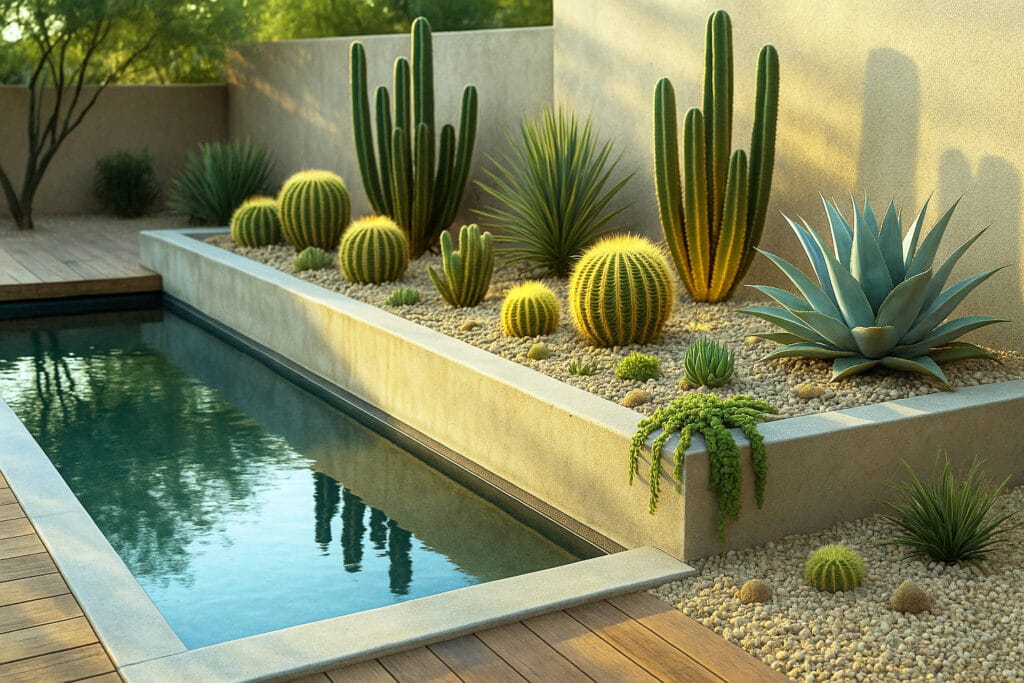

This one flips expectations — desert plants, clean lines, and water? Yep, and it works. Ideal for dry climates, this layout combines succulents and cacti with a sleek, shallow pool or basin. Add gravel and some concrete, and you’ve got a low-maintenance showstopper.
- Best plants: Agave, golden barrel cactus, aloe, firesticks.
- Pro tip: Space out the plants and go for repetition. Minimalism is the power move here.
3. Modern Minimalist Zen
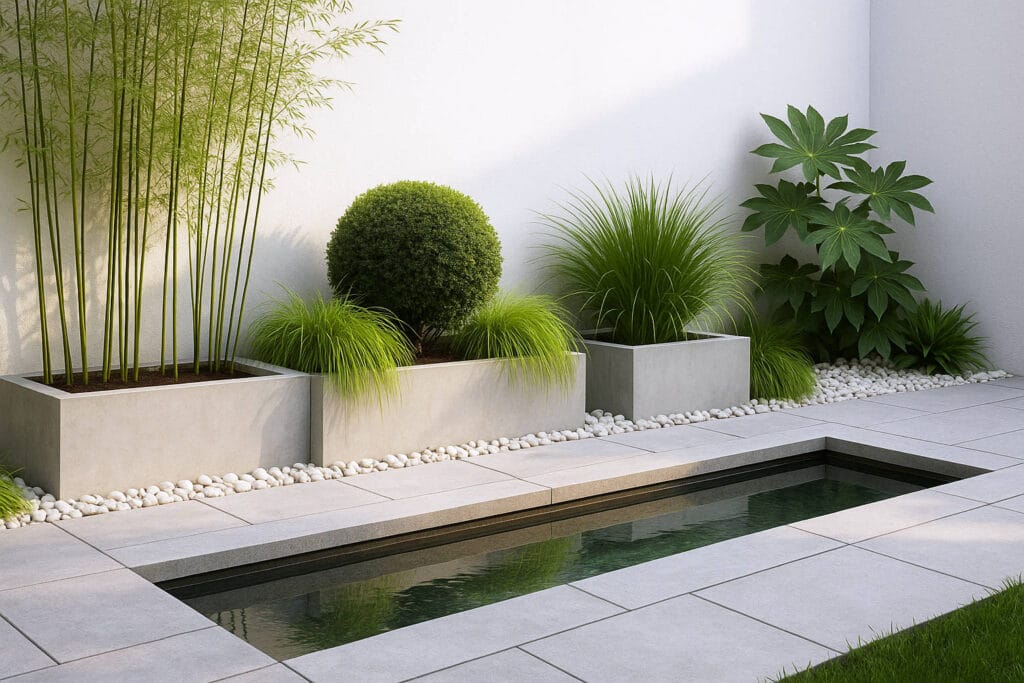

Calm, clean, and totally chill. This design blends bamboo, soft grasses, and topiary with water features that feel like they belong in a Japanese tea garden. Add concrete or wood decking for a balanced, modern look.
- Best plants: Bamboo, Japanese forest grass, fatsia, boxwood.
- Pro tip: Go for symmetry and clean edges. Let the plants and water do the talking.
4. Mediterranean Courtyard


Lavender, olive trees, and terracotta — if this doesn’t make you crave wine and sunset, nothing will. This setup turns your garden into a rustic courtyard with plant beds wrapped in warm-toned stone or clay.
- Best plants: Lavender, rosemary, thyme, olive tree.
- Pro tip: Mix textures — rough stone, soft foliage, colorful tiles — for a rich, lived-in feel.
5. Tropical Jungle Escape
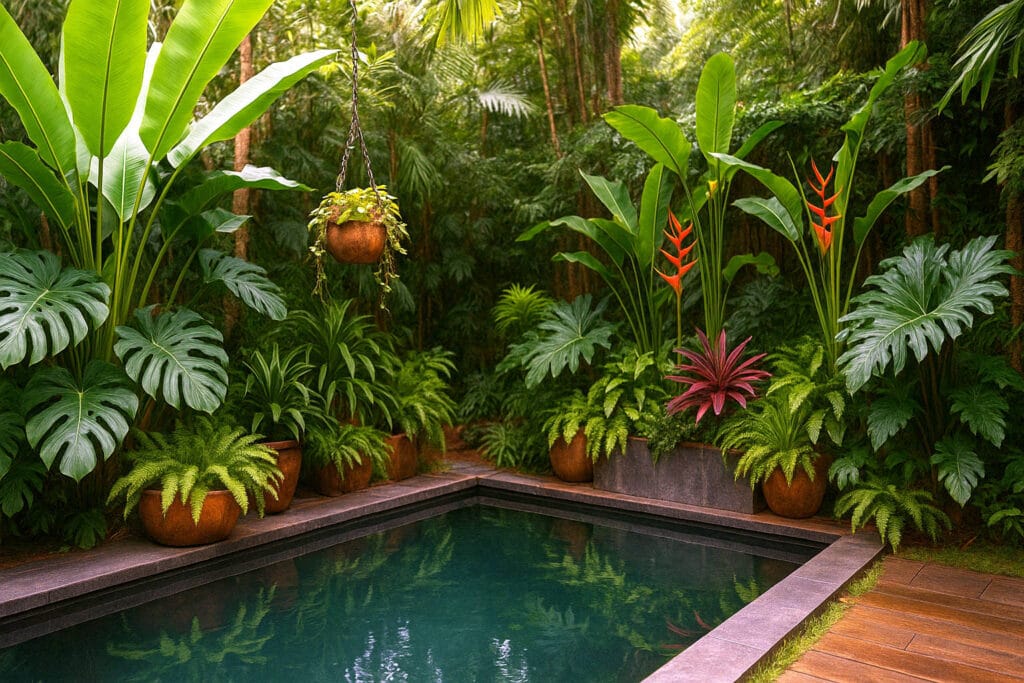

Dense. Lush. Immersive. This is the closest you’ll get to a rainforest without hopping on a plane. Perfect for shaded spots and humid areas, this design layers plants at different heights for that “lost-in-nature” feel.
- Best plants: Monstera, philodendron, heliconia, ferns, cordyline.
- Pro tip: Add a mist system or gentle water feature for humidity and that jungle soundscape.
You don’t have to copy one idea exactly. Mix elements, scale them to your space, and make it your own. That’s the beauty of planter pools — they’re flexible, personal, and guaranteed to bring life to your garden.
You may also like:
Maintenance Tips for a Planter Pool
A planter pool might look like something straight out of a design magazine, but with a bit of planning, it doesn’t have to be high-maintenance. Here’s how to keep things thriving without turning your weekends into yard duty.
1. Pick the Right Plants Up Front
Start smart. Choose plants that match your climate and sunlight conditions. Native species or drought-tolerant picks are almost always easier to care for. Tropical setup? Go for humidity-loving plants. Mediterranean look? Stick with herbs and silvery leaves that can handle dry heat.
2. Water Smart, Not Hard
Don’t drag the hose around every day. Install drip irrigation or use self-watering containers inside your planter zones. For small setups, even a slow-release watering spike does the job. Just make sure planters have drainage, especially if they’re right next to water — soggy roots are not a vibe.
3. Mind the Pool Water
If your pool is chlorinated or uses saltwater, give plants a little buffer — like raised edges or a dry border. Splash happens, but constant exposure can hurt sensitive species. For decorative basins, use clean, chemical-free water if plants are directly involved.
4. Trim, Clean, Refresh
Plants grow — that’s the point — but you’ll need to prune them back occasionally to keep things tidy. Pull weeds before they take over, and top up mulch or decorative gravel when it starts looking tired.
5. Seasonal Adjustments
Plants slow down in winter, and some won’t make it through frost. Depending on your zone, you may need to move container plants indoors, add frost cloths, or switch to hardier varieties during colder months.
A well-maintained planter pool stays beautiful without being a burden. Set it up right, and you’ll get the best of both worlds: nature and relaxation with barely any fuss.
You may also like:
Conclusion
A planter pool is one of the smartest ways to bring together two of the best things in outdoor design: water and plants. And the best part? You can totally make it your own. With the right layout, a few good plant choices, and some basic care, a planter pool turns even a small backyard into a peaceful escape.
So now you know what it is, how to build it, how to style it, and how to keep it alive. The only thing left? Start planning yours.
Want to make sure your plants survive cold snaps? Check out our guide on how to protect plants from frost, especially if your planter pool includes temperature-sensitive varieties.
FAQ: Planter Pool Questions Answered
1. What is a planter pool?
It’s a pool or water feature that includes built-in or nearby plant beds. It combines water and greenery to create a more natural, relaxing outdoor space.
2. Can I add a planter pool to a small backyard?
Absolutely. You can scale it down with a small basin and compact planters. Even a large ceramic pot with water and plants can give you the planter pool vibe.
3. Do planter pools need special maintenance?
Not really. Choose low-maintenance plants, make sure you have good drainage, and keep water clean. Occasional trimming and watering is usually enough.
4. What plants work best near water?
That depends on your climate and design. Tropical setups do well with banana plants and ferns. Mediterranean ones love lavender and rosemary. Just avoid deep-rooted plants too close to pool edges.
5. Can I use a chlorinated or saltwater pool with a planter pool setup?
Yes, but place the plants a little farther from the splash zone, or use raised planters. Some plants won’t love the chemicals, so spacing matters.
6. Is a planter pool expensive to build?
It doesn’t have to be. You can DIY a basic version with a shallow container and some plants. Bigger setups with built-in structures will cost more but can often be done in stages.


